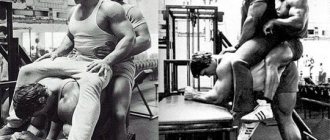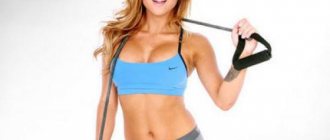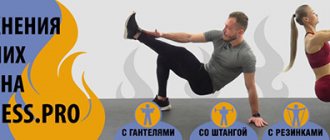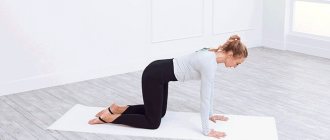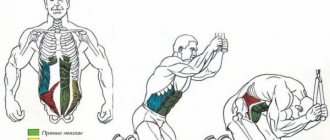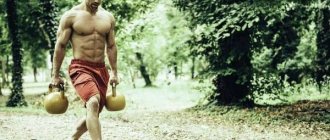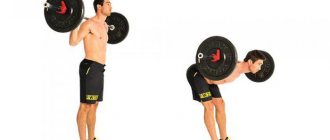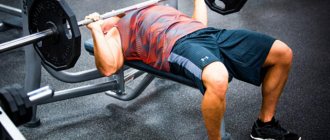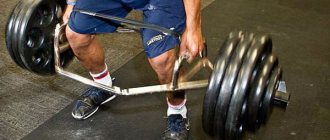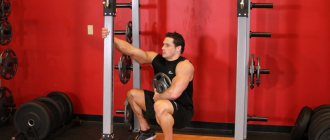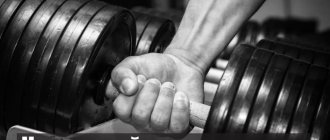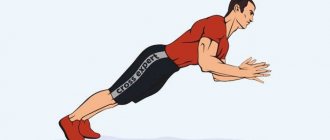March 27, 2020 Admin Home page » Legs
Learn how to give beautiful shape to the back of the thigh, the correct starting position, execution technique and important tips are described.
An isolated exercise is aimed at developing the back of the thighs. Perform after basic exercises, thus “finishing off” the exhausted muscle.
ADVIСE
1) Perform the exercises at an average pace, lift the weight with a powerful movement, applying great effort at the start, but DO NOT JERK, otherwise you will injure the ligaments of the hip and the back of the knee;
2) Don’t try to put your knee on the bench or push it too far beyond it if you don’t want problems with your knee;
3) Please note that the toes of the feet should look at the floor, and not apart or looking at each other. By the way, socks that involuntarily look to the sides indicate better development of the outer back side of the thighs, and inward - the inner side;
4) At the bottom point of descent, fully straighten your legs (BUT DO NOT RELAX THE MUSCLE), otherwise over time they will lose flexibility and will not be able to straighten completely;
5) I recommend placing a rolled up towel under your stomach, since when you lift your legs up, your lower back bends a little, causing tension in the intervertebral discs.
Execution technique
Let's look at the technique of performing the exercise while lying down. When doing curls while sitting or standing, follow the same principles.
First of all, adjust the machine to your height and leg length. The knee joints should extend beyond the edge of the bench, and the bolster into which you will rest the lower part of your shin should be located a few centimeters above your heel. Everything is simple here - the closer the roller is to the heel, the greater the leverage and the more effective the exercise. You lie down on your stomach at the bend of the bench so that you are comfortable and there is no tension in your lower back.
- Lie down on the machine and place your feet under the bolster. Use your hands to grasp the special handles or the edges of the bench.
- As you exhale, bend your shins, trying to bring the roller as close to your buttocks as possible. The front surface of the thighs is pressed against the bench.
- As you inhale, straighten your shins, gently lowering the weight down. There is no need to fully straighten your knees and relax your hamstrings at the lowest point.
- Repeat as many times as necessary.
You can vary the load in this exercise by changing the position of your toes. By pointing your toes outwards, you will shift the emphasis towards the outer thighs. Bringing them inward - towards the inner.
You can also alternate bending on the machine in a sitting or lying position. If you have an appropriate simulator, you should try to do the exercise while standing, first with one leg, then with the other. The more versatile the muscle work, the better the result you will get.
After your workout, do some stretching. This will help relax the hamstrings and improve blood circulation.
TYPES OF LEG BENDING
Standing leg curl
Perfectly works the very bottom of the back of the thigh and the top of the calf muscle.
The body should be slightly tilted forward, the leg lifting occurs to the extent that the shin is slightly above parallel to the floor (but the roller does not touch the body), at the lower point the leg is slightly bent to maintain the load. It is important that if your body leans back when lifting, reduce the weight and perform the exercise with perfect form.
Leg bending while sitting in a machine
To begin, adjust the machine to the length of your hips and height; your knees should not go beyond the bench.
The lower back and center of the back are pressed tightly against the back, lower the bolsters so that your shins at the lowest point are strictly parallel to the floor, do not place them behind the machine.
Main benefits of the exercise
- An effective effect on the leg muscles, aimed at shaping the relief.
- Helps add volume to the femoral biceps, which is often necessary when there is a significant difference in the development of the anterior and posterior muscles.
- With this exercise you can give your muscles the missing relief.
- Increases strength indicators when performing basic complexes.
- Helps prevent the appearance of subcutaneous fat deposits at the junction of the buttocks and the back of the thigh.
- There are different options for doing it, including without a simulator, which is important for home exercises.
- The exercises are accessible to beginners and easy to perform.
Lying leg curls have an impressive list of benefits. This exercise, when performed correctly, has no disadvantages, which makes it possible to include it in a variety of complexes for athletes of both sexes and different levels.
What can be replaced
Due to various circumstances, not every person can visit the gym, but it is possible to achieve a beautiful figure at home. There are even some advantages to this. Classes can be held at any convenient time and for free.
If you don’t have a machine, you can easily do these exercises on the floor. To do this, lie on your stomach, place your head on your arms bent at the elbows. Secure the dumbbells firmly between your feet and begin bending your legs.
To pump up the muscles of the legs, hips and buttocks, there are other types of training with and without a simulator. Here are some alternatives that can replace lying leg curls with dumbbells.
- Leg bending while sitting in a simulator - the back of the machine must be adjusted so that the edges of the seat are under the knees. Straighten your back and press tightly against the back. Place your feet under the cushion and rest against it. Hold the handrails firmly with your hands. Take a deep breath and, as you exhale, bend your legs under you, while your torso should be motionless. Repeat the exercise several times.
- Leg bending in a standing simulator - this type of training is especially popular among women, as it helps to tighten particularly problematic parts of the body - the hips and buttocks.
For the starting position, you need to adjust the simulator to your height, then place one leg under the roller so that it is slightly higher than the ankle, and rest your knee on the lower roller. Press your chest and stomach tightly against the pillows.
As you exhale, begin to bend your leg as high as possible. At the top position, hold your leg for 2-3 seconds. After making several movements, change your legs and repeat the movements in the same sequence.
- Wall Squat – Press your back tightly against the wall. Place your feet shoulder-width apart and your feet slightly to the side. Step back half a step from the wall, hands at your sides and tighten your abs as much as possible.
Inhale, slowly and slowly lower yourself along the wall until your knees are parallel to the floor. Stay in this position for 1-2 minutes and, as you exhale, return to the starting position. Repeat the exercise several times.
In addition to the usual wall squat, there are several other options, for example:
- squat with a ball between your legs;
- turn around to face the wall;
- squatting on one leg;
- for greater load, you can pick up dumbbells.
All of the exercise options listed above force only a certain muscle group to work. This sport normalizes blood circulation and blood pressure. For women, especially after the birth of a child, it helps to tidy up their figure and tighten problematic parts of the body.
Strengthening your back
Dumbbell row
Maintain an arch in your back as shown in the image.
To perform the exercise you will need a horizontal bench. It is necessary to perform approaches alternating hands.
First, we rest the knee of our right leg and our right hand on the bench. We bend our left leg slightly at the knee and place it on the floor. We lower the left hand with the dumbbell down.
We begin to pull the dumbbell to the belt, bringing the shoulder blades together. After 10-15 repetitions with the left hand, we change the hand, moving the legs the other way around.
The number of approaches is 3-5. The number of repetitions is 10-15.
Don’t rush to take the heaviest dumbbells, but start with a small weight and work on the correct technique
Read more: Lying leg curls in the simulator technique for making a mistake
The exercise is performed standing, legs should be slightly narrower than shoulder width. In the starting position, your arms with dumbbells should be completely lowered down.
As you exhale, engage the trapezius muscles of your back and lift your shoulders toward your ears. In the highest position, freeze for 2-3 seconds. At the same time, you cannot bend your arms.
As you inhale, slowly lower your shoulders to the starting position. And start the exercise again. When performing, you should not stand on your toes, swing or jump, helping yourself through inertia - this will steal part of the load from the target muscles.
It will be enough to do 3-4 sets of 15-20 repetitions.
1A Bench press on the floor
Technique: Lie on the floor, holding dumbbells with straight arms above your chest. Lower the weight to your chest, then lift it up to the starting position.
Note: Lying on the floor provides you with a stable position that allows you to handle heavier weights. The range of motion here is shorter than the classic bench press, so focus on properly contracting your chest muscles.
Technique: Hold a dumbbell in each hand with your palms facing each other. Bend forward and then pull the dumbbells toward your chest. Using a controlled movement, lower the weight back to the starting position.
Note: This exercise targets the large muscles of the upper back. Its lower part is under tension to support the torso in an inclined position. The hammer grip allows you to work your forearms.
Technique: take dumbbells, take a lying position with your hands shoulder-width apart. Brace your core and straighten your body into a straight line from head to toes. Bend your elbows, lower your body, and then with an energetic movement, straighten your arms and return to the starting position.
Note: Push-ups are effective for building chest muscles, especially when you use dumbbells to add instability to the movement, which forces your core muscles to engage.
Technique: Hold a light dumbbell in each hand and lean forward without rounding your back. Maintaining a slight bend in your elbows, lift the dumbbells to shoulder height, then lower them back to the starting position.
Note: This exercise literally works wonders for your upper back and rear deltoids. Start with light weights and master the technique thoroughly to maximize muscle strength and reduce the risk of injury.
Technique: Take dumbbells, lie down, spread your arms wide and bring your legs together. Brace your core and straighten your body into a straight line from head to toes. Bend your elbows to lower your body, and then vigorously straighten your arms and return to the starting position.
Note: Wide stance reduces the involvement of the triceps and shoulders, so that the main load falls on the chest muscles.
3B Lying dumbbell row
Technique: take dumbbells, lie down with your hands shoulder-width apart. Brace your core and straighten your body into a straight line from head to toes. Pull one dumbbell toward your chest, lower it back down, and then repeat with the other arm.
Note: One movement of this exercise works one side of your upper back (so you can fully target every muscle) and also forces you to engage your core and shoulder joints to keep your body in a stable position.
Week 2
| Exercise | Approaches | Repetitions | Rest, sec | Pace |
| 1A Bench press on the floor | 4 | 12 | 2010 | |
| 1B Bent-over row with hammer grip | 4 | 12 | 60 | 2010 |
| 2A Push-ups with dumbbells | 4 | 12 | 2010 | |
| 2B Bent-over dumbbell raises | 4 | 12 | 60 | 2010 |
| 3A Push-ups with wide arms | 4 | 12 | 2010 | |
| 3B Lying dumbbell row | 4 | 12 per side | 60 | 2010 |
Week 3
| Exercise | Approaches | Repetitions | Rest, sec | Pace |
| 1A Bench press on the floor | 4 | 10 | 2010 | |
| 1B Bent-over row with hammer grip | 4 | 10 | 60 | 2011 |
| 2A Push-ups with dumbbells | 4 | 10 | 2010 | |
| 2B Bent-over dumbbell raises | 4 | 10 | 60 | 2011 |
| 3A Push-ups with wide arms | 4 | 10 | 2011 | |
| 3B Lying dumbbell row | 4 | 10 per side | 60 | 2010 |
Week 4
| Exercise | Approaches | Repetitions | Rest, sec | Pace |
| 1A Bench press on the floor | 5 | 12 | 2010 | |
| 1B Bent-over row with hammer grip | 5 | 12 | 60 | 2011 |
| 2A Push-ups with dumbbells | 5 | 12 | 3010 | |
| 2B Bent-over dumbbell raises | 5 | 12 | 60 | 2011 |
| 3A Push-ups with wide arms | 5 | 12 | 3010 | |
| 3B Lying dumbbell row | 5 | 12 per side | 60 | 2011 |
Basic pectoral muscle development
Feet should be placed on the floor, creating a confident support for the body
This exercise will require a little preliminary preparation. It is necessary to place the bench at an angle of about 30-40º. It is also recommended to secure it firmly so that it does not wobble. Lie down on a bench with your feet comfortably on the floor.
In the starting position, your elbows should be below or at the same level as the bench. Next, raise your arms up as you exhale. Slowly inhaling air, return to the starting position.
Outwardly, this should resemble a regular bench press. Make sure your hands are always level with each other.
Number of approaches - from 3 to 5. Number of repetitions - from 8 to 12.
While performing these steps, try to keep your back straight and not sway.
The first exercise is performed while standing on the floor. Place your feet shoulder-width apart. Hold a dumbbell with both hands and extend your arms forward at shoulder level. Begin to pull the dumbbell towards your chest, bending your elbows. Then return to the starting position.
The second exercise is called scissors. It must be performed standing with your feet shoulder-width apart. Straighten your arms in front of you with dumbbells and alternately perform overlapping movements. For example, first move your right hand over your left, and then vice versa.
The number of approaches is 3-5. Number of repetitions - 8-12.
Developing your hands
The elbow should remain in place while performing repetitions.
"Hammer"
The exercise is performed standing, with your feet shoulder-width apart. In the starting position, your arms should be down. Turn your palms towards you.
As you exhale or while holding your breath, bend your elbow and lift the dumbbell with your right hand to your shoulder. As you inhale, lower your hand to the starting position. Next, do the same thing, but with your left hand.
When performing this exercise, the body and elbows should be motionless. Even with just 10-15 repetitions, you can fully feel the work of your biceps. The hammer must be performed at a slow pace.
The number of approaches is 3-5. The number of squats is 8-12.
Try to do the exercises without swaying
Two more exercises are suggested. The first exercise is performed standing on the floor or sitting on a chair. In the first case, your feet need to be placed shoulder width apart.
Hands with dumbbells should be spread out to the sides, palms up. We begin to bend our elbows, lifting the dumbbells to shoulder level.
The next exercise requires a chair or bench. It must be performed alternately with each hand. We sit on a chair and spread our legs wide apart. We bend our back slightly forward.
We rest the elbow of our left hand on the knee of our left leg. We begin to bend our arm at the elbow, bringing it to the shoulder. Then repeat the exercise with your right hand.
Both in the first exercise and in the second, while lifting the dumbbells up, you need to twist the hand outward.
The number of approaches is from 3 to 5. The number of repetitions for each hand is from 10 to 15.
It is recommended to practice in front of a mirror to monitor the correct technique for performing the exercises.
To develop your triceps, you can perform the following exercises. The first is performed while standing, with your feet shoulder-width apart. In the starting position, hold the dumbbells with both hands above your head.
As you inhale, lower it to the back of your head, and as you exhale, press it to the starting position. Your elbows should not move from side to side; keep them parallel to each other.
The second exercise is done similarly, but for each hand separately. This will allow you to lower the dumbbell even lower, which will increase the range of motion.
The number of approaches is 3-5. The number of repetitions for each hand is 8-12.
Nuances
- your knees should hang slightly off the machine bench;
- in a bent position of the legs, the angle should be at least 90 degrees;
- movements should be performed slowly and smoothly with the muscles of the buttocks compressed and tense;
- Initially, you should not use a load of more than 10 kilograms;
- to improve the result and increase the load on the muscles, it is recommended to place a cushion or rolled up towel under the lower back;
- strictly observe breathing technique;
There are two types of machines for this exercise: with a straight horizontal bench and with a curved one. The execution technique will be considered correct when the body position corresponds to the design of the selected simulator.
Workout 3: Legs and Abs (Week 1)
Squats
Pay attention to the correct position of the back
An excellent basic exercise is the classic squat. There is no doubt about their benefits, both among bodybuilders and powerlifters.
Place your feet shoulder-width apart or slightly wider. Taking the dumbbells in your hands, begin to squat slowly.
As you inhale, you need to squat down until it is parallel to the floor, and as you exhale, you need to return to the starting position.
By squatting below 90 degrees to the floor, you can additionally load the gluteal muscles.
Number of approaches - from 3 to 5. Number of repetitions - from 10 to 15.
Movements should be done slowly and carefully so as not to injure your knees.
Lunges
To do this, take dumbbells in your hands and straighten them down. Place your left leg forward.
The right straight leg is laid back, the knee is in weight, the toe is resting on the floor. We lunge forward on the left knee.
Then, change stance and repeat the exercise for the right leg. Remember to maintain balance and keep your back straight.
You cannot cross your legs, as this risks losing your balance and falling to the floor, which can lead to injury.
We keep the number of repetitions at 10-15, approaches - 3-5.
The exercise is performed standing, with your feet shoulder-width apart. Lower your hands with dumbbells down along your body. Rise up onto your toes and hold in this position for 5-10 seconds. Then, slowly return to the starting position.
Number of approaches - from 3 to 5. Number of movements - from 10 to 15.
1A Squats
Sets: 4, reps: 10, rest: 0 sec, tempo: 2010
Technique: Hold a dumbbell in each hand and stand straight. Tighten your core and squat down as deeply as possible. Push your heels off the floor and stand up to return to the starting position.
Note: This is a classic exercise for building big, strong legs. Since squats work multiple muscle groups, they are also very effective for burning belly fat.
1B "Lumberjack"
Sets: 4, reps: 10, rest: 60 sec, tempo: 2010
Technique: Stand up straight, holding a dumbbell in both hands above your shoulder. Squat down, lowering the dumbbell in an oblique line across your body. Reverse the movement to return to the starting position. Do the prescribed number of repetitions and switch sides.
Note: This exercise works the core, shoulders, and lower back muscles.
2A Lunges
Technique: Take dumbbells, stand straight and lower your arms along your body. Brace your core, take a large step forward so that your legs are bent at a 90° angle, then push off with your front leg and return to the starting position. Complete the prescribed number of repetitions on one leg and move on to the other.
Read more: How to increase a man’s waist, exercises to increase the waist
Note: Lunges work many of the same muscles as squats, but with more emphasis on the core since the abdominal muscles must work harder to maintain body balance.
Technique: Stand up straight, lift the dumbbell above your head and move it clockwise. Complete all repetitions, and then repeat the same movement, but this time counterclockwise.
Note: This exercise works the abdominal muscles, which must be fully contracted to support the torso in an upright position. It also strengthens the shoulder joints.
Technique: Stand up straight, holding a dumbbell in front of you with both hands. Keeping your back straight and your core engaged, squat down until the dumbbell almost touches the floor. Stand up to return to starting position.
Note: in addition to building muscle mass, this exercise allows you to maintain a high heart rate, which will have a positive effect on fat burning.
3B Crunches
Technique: Lie on the floor, holding a dumbbell on your chest. Tighten your abdominal muscles, lift your torso, and then slowly lower yourself back down.
Note: crunches are a very effective way to work your upper abs. Additional weights in the form of a dumbbell will allow you to work the target muscles even better and raise and lower your torso without the help of inertia of movement.
Week 2
| Exercise | Approaches | Repetitions | Rest, sec | Pace |
| 1A Squats | 4 | 12 | 2010 | |
| 1B "Lumberjack" | 4 | 12 per side | 60 | 2010 |
| 2A Lunges | 4 | 12 per side | 2010 | |
| 2B Dumbbell Overhead Rotation | 4 | 12 per side | 60 | 2010 |
| 3A Goblet Squats | 4 | 12 per side | 2010 | |
| 3B Crunches | 4 | 12 | 60 | 2010 |
Week 3
| Exercise | Approaches | Repetitions | Rest, sec | Pace |
| 1A Squats | 5 | 10 | 3010 | |
| 1B "Lumberjack" | 5 | 10 per side | 60 | 1111 |
| 2A Lunges | 5 | 10 per side | 3010 | |
| 2B Dumbbell Overhead Rotation | 5 | 10 per side | 60 | 1111 |
| 3A Goblet Squats | 5 | 10 per side | 3010 | |
| 3B Crunches | 5 | 10 | 60 | 2011 |
Week 4
| Exercise | Approaches | Repetitions | Rest, sec | Pace |
| 1A Biceps curl | 5 | 12 | 3010 | |
| 1B Extension of the arm from behind the head | 5 | 12 per side | 60 | 1111 |
| 2A Hammer Grip Dumbbell Raise | 5 | 12 per side | 3010 | |
| 2B Bent-over arm extension | 5 | 12 per side | 60 | 1111 |
| 3A Squat Curl | 5 | 12 per side | 3010 | |
| 3B Push-ups with dumbbells with narrow arms | 5 | 12 | 60 | 2011 |
How to get big and strong legs without barbell squats
Although squats are undoubtedly the best exercise for the legs, you can still build powerful muscles with other lower body exercises, examples of workouts are attached.
The squat is the king of all bodybuilding exercises. It develops overall strength and is suitable for training, whatever your level or goal. When it's Men's Leg Day, it goes without saying that you'll start with a good dose of squat sets. But is it possible to achieve the same results for the lower body without squats?
The answer is yes, and here you will learn how to pump up your legs in the gym and increase their muscle mass without squats with a barbell using other effective exercises.
First of all, it is impossible to deny that squatting is the best way we develop a strong and resilient pair of legs. It would be wrong and dishonest to deny this. But there are a number of situations where even a correctly performed squat can cause harm, and in such a way that you will end up missing valuable time in the gym due to injury or pain.
During a squat, the entire body is tense, and most of this stress is placed on the knees and lower back. Wristbands and a belt can help, but they cannot completely prevent injury. And it’s not even that there’s something wrong with your technology; You can injure your knee by performing a completely correct squat. On the other hand, incorrect technique usually serves as a catalyst for nagging lower back pain.
Seated leg extension
When you looked at a photo of leg extensions in a simulator, you probably saw an option in which the athlete sits on a bench. This movement is suitable for beginners.
Although there are nuances here:
- First, bend your knees at a right angle. Do not place your feet under the seat, otherwise you may get injured.
- Slowly straighten your knees and hold, so that the quadriceps remain under tension longer.
- If you bring your toes together, the load will be on the outer part of your quadriceps. And if you spread your socks to the sides, the ligaments will become strained. Be sure to pull your toes back so that your quadriceps are pumped evenly.
